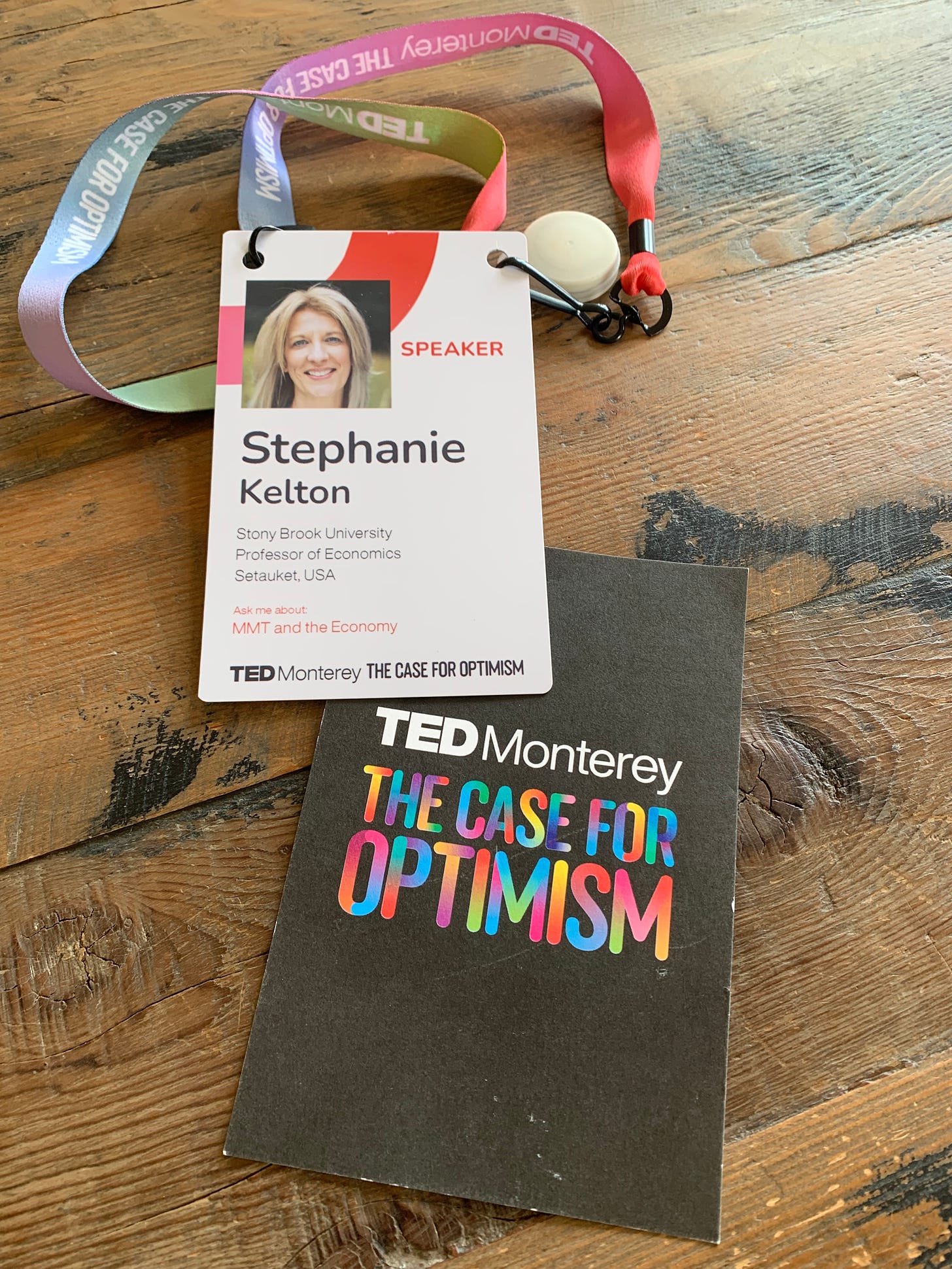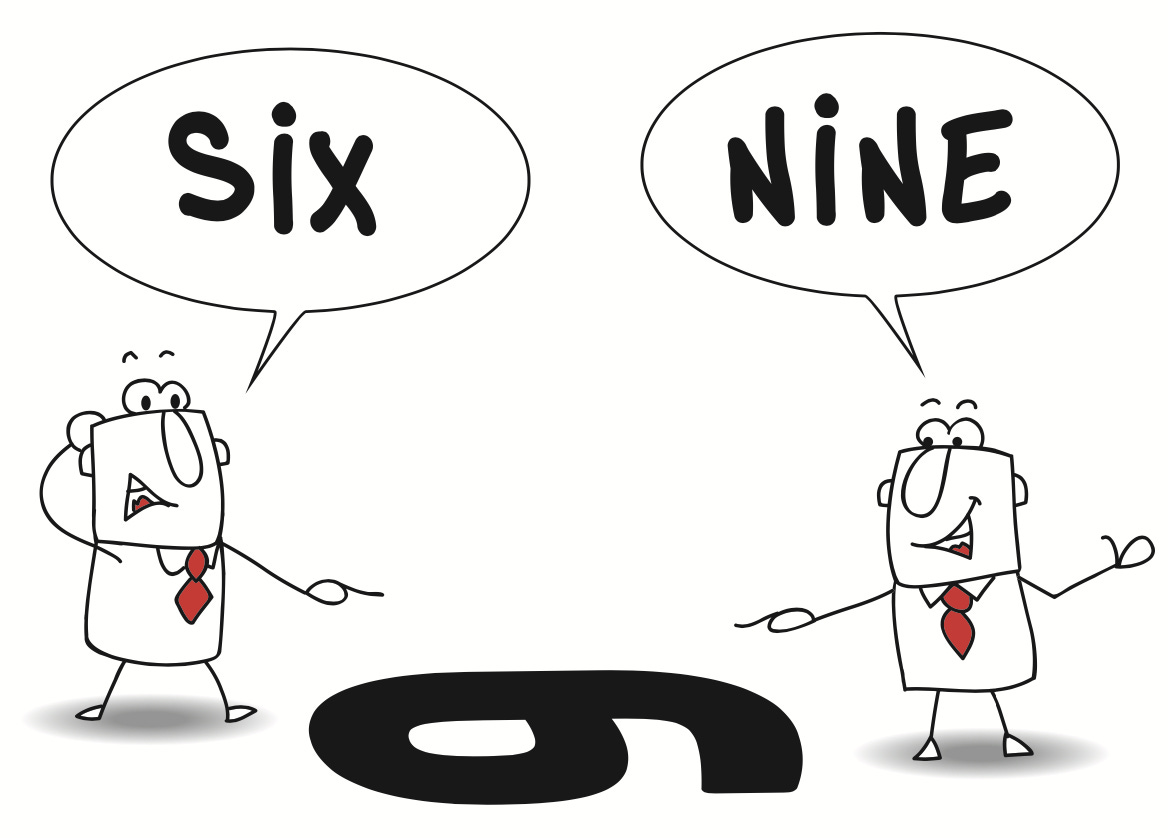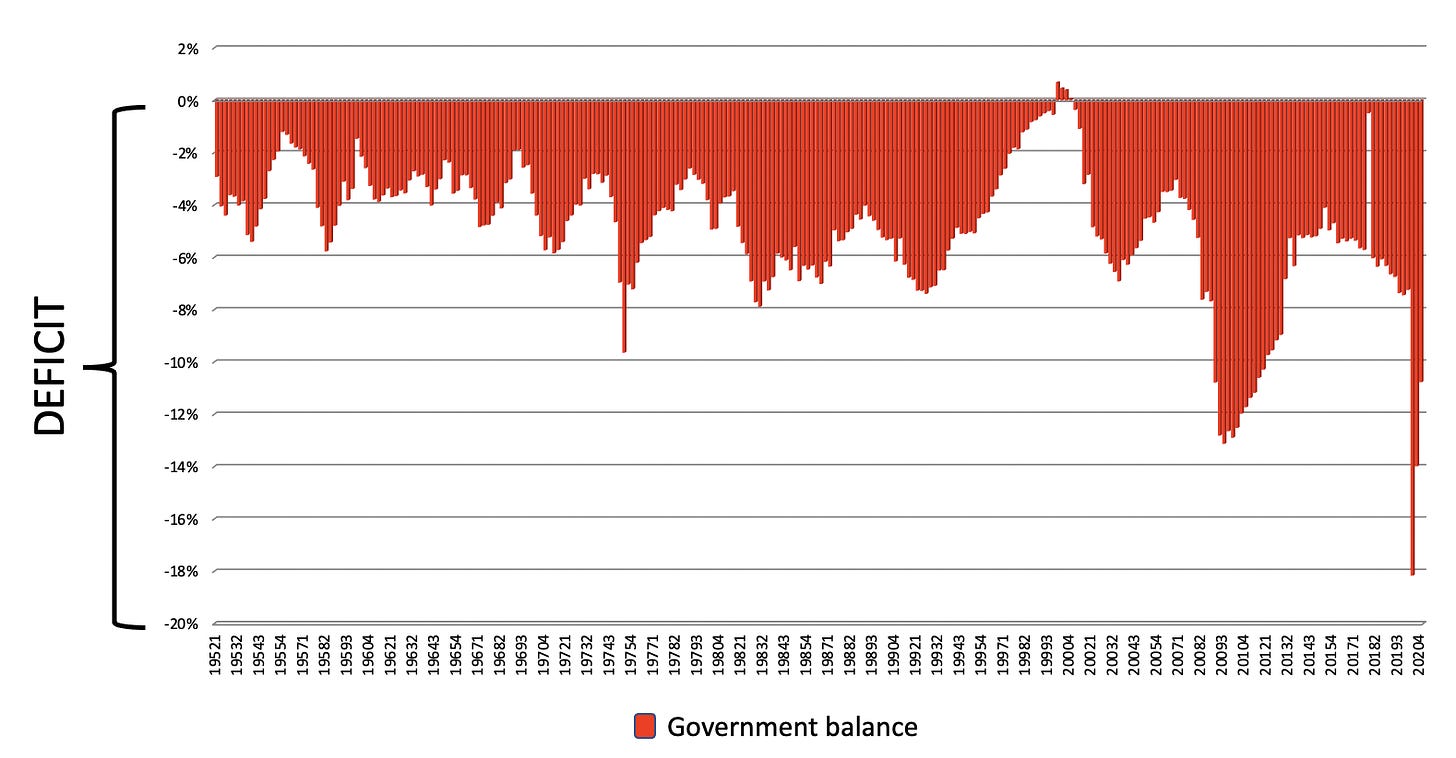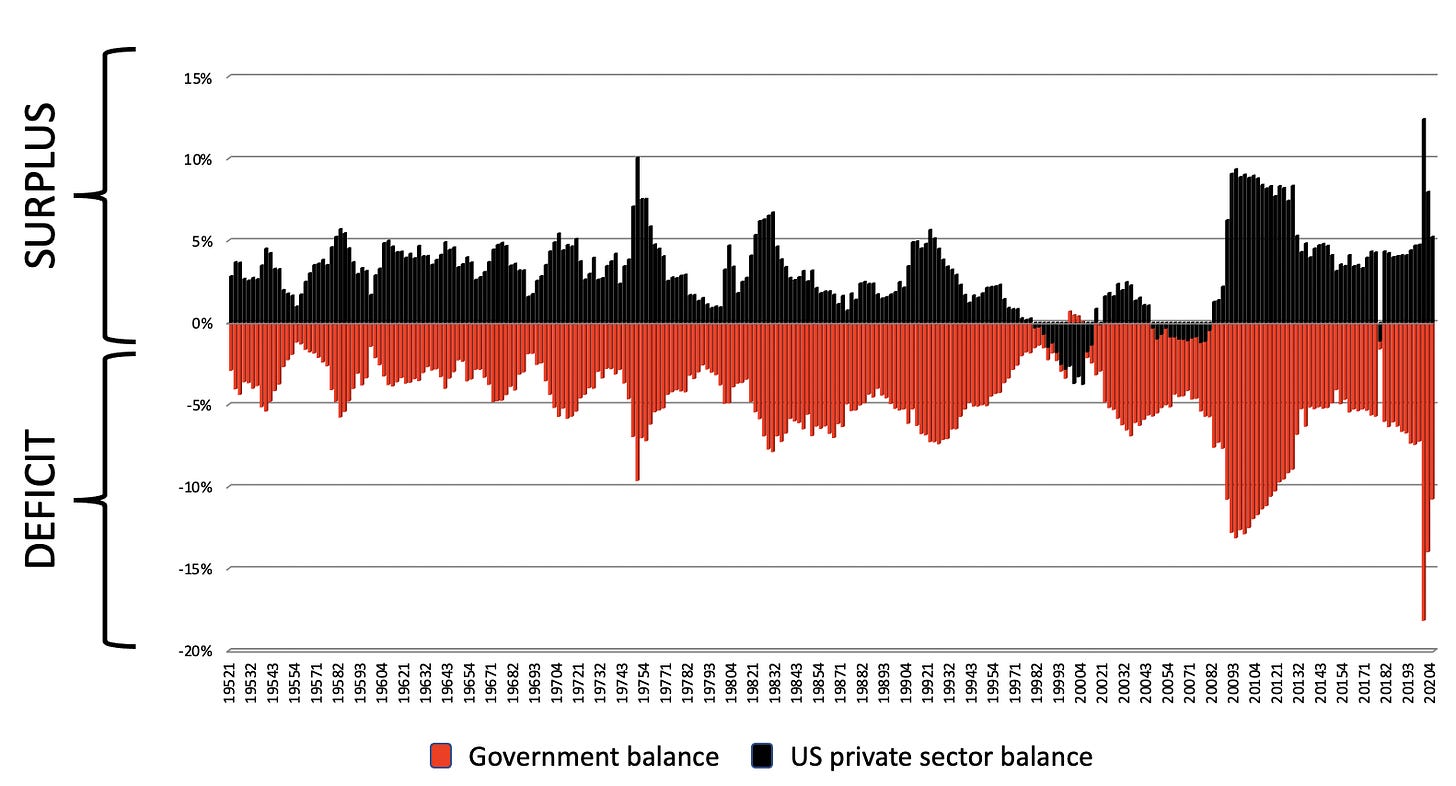I’ve long wanted to give a TED talk. So when Chris Anderson’s team reached out to tell me that they’d read my book and that MMT was an idea worth spreading, I jumped at the chance to appear in the red circle.
A TED talk isn’t like giving a classroom lecture. And it’s not like giving a keynote address or delivering other remarks before a large audience. It takes some degree of preparation to do any of those things well, but it’s nothing like preparing for TED. A TED talk is a tightly-scripted articulation of some big idea that you hope will captivate, educate, and inspire your audience. In about twelve minutes. Without notes.
I joked on Twitter that writing a 1,700-word script for the TED talk was harder than writing the book. By far, the most painstaking part was deciding what to leave out.
The event took place last week, in Monterey, California. It was like nothing I’d ever experienced. The support. The camaraderie. The excitement. It made weeks of grueling preparation totally worthwhile.
It will be some time before the video is available online, but here’s the script.
When things break, we have an opportunity. We can pick up the pieces and put them back together the old way, or we can look for better ways to build. COVID broke everything. It put a spotlight on the many deficits in our economy – in employment, education, health care, housing. And it showed how inequality made it all worse.
Here in the US and around the world, governments did some extraordinary things. They sent money to people—directly—to help them buy food and pay rent. They provided free COVID testing and expanded health care to cover more of the population. They gave money to businesses to help them stay afloat while much of the economy was temporarily shut down. They offered debt relief to millions of people who borrowed money to go to college. They did all of this—and more—without raising taxes or having a prolonged battle over the usual question of how to “pay for” it.
Congress simply voted for the spending and calmly allowed it to increase the fiscal deficit. To me, this was exciting. And I’m an economist, so I don’t say that a lot.
But as someone who’s been trying to change the way we think about deficits and government spending, I saw this as an opportunity to show why government budgets don’t work like household budgets, why all of their red ink is really our black ink, and why our nation can afford to keep investing in the things we need, even after spending trillions to fight the pandemic.
For a while, it looked like the US and other countries were starting to break the mold on the old way of thinking about deficits and taxes. But now here we are—just a handful of months after all of that bold action—and we’re sliding back into our old habits of thought. Can we build affordable housing and repair our crumbling infrastructure? Can we expand Medicare to include dental, vision, and hearing? Can we tackle our climate crisis? As Congress debates these questions, everyone is back to asking, “How will we pay for it?”
It’s the wrong question. In fact, the right questions aren’t about money at all. Instead of asking where the financing will come from, we should be asking: Are these things worth doing and do we have the real resources—the people, the equipment, the raw materials, and the technology—to do them? Will they make society better off, and do we have the political will to act?
I am one of a small number of economists who contributed to the body of academic scholarship that’s known as MMT, or Modern Monetary Theory. MMT provides an accurate description of how a fiat currency—like the US dollar or the British pound—actually works. It reminds us that we’re no longer on a gold-standard, so “finding the money” to pay for the things we need is never an issue for countries like the US or the UK.
If we’re going to fix what’s broken in our economy, we have to fix the way we think about the limits on government spending. Let me give you an example of the kind of broken, gold-standard thinking that still permeates our discourse.
Back in 1983, the Prime Minister of Great Britain--Margaret Thatcher--said these words:
“If the state wishes to spend more, it can do so only by borrowing your savings or by taxing you more. And it’s no good thinking that someone else will pay, that someone else is you. There is no such thing as public money, there is only taxpayer’s money.”
Maybe you’ve heard the contemporary version of Thatcher’s dictum?
“There is no magic money tree.”
It’s just another way of saying that everything must be “paid for” and that the taxpayer is ultimately on the hook for whatever the government spends.
It sounds worrying.
As individuals, we know from our own experience that when we borrow money to go to college, start a business, or buy a home, we’re personally saddled with that debt. We have to find the money to pay it back. Taking on too much personal debt can lead to all sorts of problems. Even small businesses and large corporations have to walk a fine line when it comes to debt. But the federal government is fundamentally different.
Unlike the rest of us, Congress never has to check the balance in its bank account to figure out whether it can afford to spend more. As the issuer of the currency, it doesn’t have to worry about running out of money. It can afford to buy whatever is available and for sale in its own currency. That might involve spending on roads and bridges, a military arsenal, or hospitals and schools. Finding the votes to pass a spending bill can be hard, but finding the money is never a problem. They just create it.
Here’s how it works. Whenever Congress and the president agree to spend more, the government’s bank—the Federal Reserve—works with the rest of the financial system to get that money into our accounts. Everything happens electronically, so there’s no physical “printing” of money involved. If you got a $1,400 check from the federal government earlier this year, or if your company received money to help cover payroll and other expenses, then you got some of the newly-minted digital dollars that were created to support our economy. No taxpayers were involved in the process. It was all done using nothing more than a computer keyboard.
So why are we hearing so much about the need to raise taxes to “pay for” infrastructure and make other investments in our economy? In a word….deficits.
We’ve all been conditioned to worry about deficits, so lawmakers are looking for ways to spend more without adding to the deficit. That’s what this whole “pay for” game is about. Unfortunately, government deficits have gotten a bad rap. They’re almost always seen in a negative light.
I’d like to change that.
When we hear the word deficit, we probably think of a shortfall or a deficiency. A deficit always sounds ominous. So when we hear that the government just ran a $3 trillion budget deficit, it can spark worry and even outrage. But there’s another way to think about government deficits.
Just as a 6 becomes a 9 when you view it from a different angle, a government deficit becomes a financial surplus when you look at it from another perspective. A deficit hawk might look at this picture and see nothing but a sea of worrying red ink.
That’s not how I look at it.
Here’s what I see.
I see what’s happening on the other side of the government’s ledger.
When the government spends more than it taxes away from us, it makes a financial contribution to some other part of the economy. Their red ink is our black ink! When you look at it this way, it becomes clear that every deficit is good for someone!
The question is, for whom? And what are those deficits being used to accomplish? It matters how the money is spent and who ends up with the resulting surplus. Tax cuts that create huge windfalls for those at the top without spurring investment and opportunities for the rest of the population don’t make good use of deficits. On the other hand, spending trillions to support our economy during the pandemic, put the deficit to good use. We just had the shortest recession in US history!
To me, that was fiscally responsible. Being responsible shouldn’t mean running the government’s finances like a household. Instead of trying to keep the deficit in check, Congress should be focused on keeping inflation in check. That’s the real limit on spending. And it’s the thing to watch out for if you’re aiming to spend trillions on things like infrastructure, health care, and free college.
Instead of asking, “How will we pay for it?” Congress should be asking, “How will we resource it?”
To answer that question, we need to think of people, factories, equipment, and natural resources like iron and wood. If we’re going to build high-speed rail, fix crumbling roads and bridges, and green our economy, we’ll need steel, concrete, and lumber. We’ll need construction workers, architects and engineers. We’ll need companies that can fill thousands of orders for solar panels, EV charging stations, and electric school buses. If our economy has the productive capacity to quickly supply all of those things, then we can easily resource it.
Or take health care. Or free college. Paying the bills to expand Medicare so that it includes dental, vision, and hearing is easy. The challenge is making sure we have enough dentists, optometrists, and audiologists to treat everyone who needs care. And if you want to resource free college, then you need the faculty, the classrooms, and the dormitories to teach and house additional students.
In a full employment economy, all of these resources are... well...fully employed. There’s no spare capacity anywhere in the system. So if the government suddenly tried to make all of these investments at once, it would quickly discover that it doesn’t have the people or the building materials to do the work. To get the resources it needs, it would have to compete with the private sector, bidding up wages and prices. That would be inflationary, and it would be fiscally irresponsible.
We’re a long way from full employment. We have the resources we need to begin repairing our broken systems. But we have to believe it’s possible. We shouldn’t let words like “debt” and “deficits” hold us back. With a better understanding of public money—where it comes from and how it works—we can take aim at the many real deficits that are bearing down on us. In every crisis lies an opportunity. We can pick up the pieces and try to reassemble the fragile systems that were in place before the pandemic. Or we can build anew, shaping our bountiful resources into the kind of world we want to inhabit. One that cares for our people and our planet. I truly hope we choose to be bold.
THANK YOU!







My compliments on the graphics. Outstanding communication. Who's idea? Who's the artist?
Classis piece.Our world is increasingly precarious and government so far deliberately choose to fix the broken system.
What's more important than money is human capital.Without humans,nobody bring resources to the hands of us.We should pay them more.
We've already know poverty is lack of money not character.